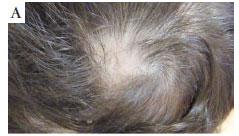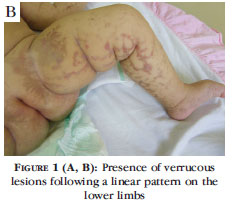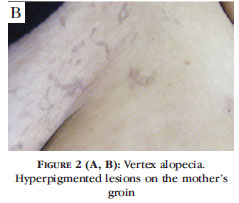Abstracts
Bloch-Sulzberger syndrome (incontinentia pigmenti) is a rare genodermatosis that affects predominantly females, since it is generally lethal to male fetuses in utero. It is characterized principally by skin lesions, but may also involve dental, ophthalmological and neurological abnormalities. The skin lesions are present in four different phases: vesicular, verrucous, hyperpigmented and atrophic/hypopigmented. Their sequence is irregular and overlapping of stages is common
Incontinentia pigmenti; Pigmentation disorders; Skin diseases, genetic
A Síndrome de Bloch-Sulzberger (Incontinência Pigmentar) é uma genodermatose rara, que afeta, principalmente, o sexo feminino, pois costuma ser letal em pacientes do sexo masculino intraútero. Caracteriza-se, principalmente, pelas manifestações dermatológicas, podendo também apresentar anomalias dentárias, oftalmológicas e neurológicas. As lesões cutâneas apresentam 4 fases distintas: vesiculosa, verrucosa, pigmentar e atrófica; que podem seguir uma sequência irregular, havendo até sobreposição das mesmas
Dermatopatias genéticas; Incontinência pigmentar; Transtornos da pigmentação
SYNDROME IN QUESTION
Do you know this syndrome?*
Isabella Brasil SucciI; Fernando Colonna RosmanII; Elisa Fontenelle de OliveiraIII
IDermatologist. Preceptor of the Postgraduate Course on Dermatology, Professor Azulay Institute of Dermatology, Santa Casa da Misericórdia do Rio de Janeiro (IDPA-SCMRJ), Rio de Janeiro, Brazil
IIPathologist, Hospital Municipal Jesus (HMJ), Rio de Janeiro, Brazil
IIIDermatologist, Hospital Municipal Jesus (HMJ). Responsible for the Pediatric Dermatology Outpatient Clinic, Professor Azulay Institute of Dermatology, Santa Casa da Misericórdia do Rio de Janeiro (IDPA-SCMRJ), Rio de Janeiro, Brazil. Substitute Professor at the Pedro Ernesto Hospital, State University of Rio de Janeiro (UERJ), Rio de Janeiro, Brazil
Mailing address
ABSTRACT
Bloch-Sulzberger syndrome (incontinentia pigmenti) is a rare genodermatosis that affects predominantly females, since it is generally lethal to male fetuses in utero. It is characterized principally by skin lesions, but may also involve dental, ophthalmological and neurological abnormalities. The skin lesions are present in four different phases: vesicular, verrucous, hyperpigmented and atrophic/hypopigmented. Their sequence is irregular and overlapping of stages is common.
Keywords: Incontinentia pigmenti; Pigmentation disorders; Skin diseases, genetic
CASE REPORT
A two-month old infant presented with disseminated vesicles, pustules and blisters since birth. Initially, these lesions developed on the lower limbs, later disseminating to the abdomen and upper limbs. The infant was diagnosed with impetigo and prescribed cephalexin. The number of lesions increased and the infant was referred to the outpatient department of pediatric dermatology. Dermatological examination revealed linear verrucous lesions, principally in the flexor region of the limbs (Figures 1A and 1B). Vertex alopecia was also found (Figure 2A).
The infant's mother had areas of hyperpigmentation in her groin (Figure 2B) and reported a history of a rash in infancy.
Full blood count revealed eosinophilia of 11%. Biopsy of a verrucous lesion on the right thigh showed spongiosis, eosinophilic infiltration and melanophages (Figures 3A and 3B).
DISCUSSION
Bloch-Sulzberger syndrome (incontinentia pigmenti) is an ectodermal X-linked dominant disorder that affects the skin, eyes and teeth, and may be associated with neurological defects. 1,2 It affects approximately 1 in every 50,000 liveborn infants and is typically lethal to male fetuses in utero. A family history of the disorder is found in around 50% of cases. 2
The name incontinentia pigmenti (IP) describes a nonspecific histological characteristic in which there is melanin incontinence of the melanocytes in the basal layer of the superficial dermis. 3
Nuclear factor kappa B (NF-KB) regulates the expression of various genes, including cytokines and adhesion molecules. Activation of NF-KB also confers protection against apoptosis induced by tumor necrosis factor (TNF). The NF-KB essential modulator (NEMO) gene is indispensable in the process of NF-KB activation. 4,5 Recently, the cause of IP was attributed to a mutation that inactivates the NEMO gene located at chromosome X (q28). 2
The cutaneous presentation of IP regresses spontaneously through the selective elimination of the cells with mutant chromosome X and their gradual substitution by normal cells. 2 Dermatological signs are generally the first to be noticed and are present in practically all patients. 4
In 90% of all cases, the skin lesions appear within the first two weeks of life and are characterized by four phases: vesicular, verrucous, hyperpigmented and atrophic. The sequence and duration of these phases may vary and they may overlap. 1,6
In the first phase, vesicles or pustules are generally preceded by erythema, which may develop on any part of the body except for the face. They develop in the first few weeks of life and disappear around the fourth month. They form a linear pattern on the limbs and a circular pattern on the trunk. Eosinophilic infiltration is found in the epidermal vesicles. The patients present with peripheral leukocytosis and eosinophilia. 1,3 The condition is often confused with herpes lesions or bacterial infection. 4
In 70% of cases, the vesicular phase is followed by the verrucous phase, generally appearing in the distal part of the limbs as soon as the blisters begin to heal, becoming dry and hyperkeratotic. They rarely affect the trunk or the face, but may occur on the scalp. 3 This phase lasts for several weeks, with the lesions becoming lighter in color at 6 months of age in 80% of patients. 4
The next phase affects 98% of patients, with hyperpigmentation that usually disappears by the end of the second decade of life. The lesions are circular and linear, brownish in color, and follow the lines of Blaschko. 4 They are more apparent on the trunk than on the limbs. The buttocks are often affected, while the axilla and groin areas are invariably affected. 3 The hyperpigmented areas generally do not correspond to the areas previously affected with vesicles or inflammation; therefore do not represent a process of postinflammatory hyperpigmentation. 4
The fourth phase is characterized by atrophic, hyperchromic linear lesions and an absence of hair. It affects the limbs in 77% of cases and occurs in adolescents and adults. These alterations tend to be permanent and are the only sign of skin involvement in adults. 4
The most common manifestation related to the hair is vertex alopecia, which occurs in 38% of patients. Punctiform depressions or ridges may occur in the nails, often disappearing with time. Periungual or subungual tumors have also been found. Fingernails are more often affected than toenails. 4
The teeth are affected in 80% of cases, this being the most common non-cutaneous manifestation of IP. Unlike the skin lesions, these abnormalities are permanent. Both deciduous teeth and permanent teeth are affected, and hypodontia and anodontia are common. 4 Conical teeth occur in 30% of cases.
Ophthalmological alterations are among the most severe manifestations of this disease. Asymmetrical involvement is common. Strabismus, nystagmus, cataract and optic nerve atrophy are common. Lesions of the retina are the consequence of vaso-occlusive events. These ophthalmological manifestations are often associated with neurological deficits that include convulsions, spastic paralysis, motor retardation and microcephaly. 4 The incidence of neurological abnormalities is lower in cases of familiar IP. 3
Imaging tests such as computed tomography, magnetic resonance imaging and angiography are useful for evaluating ophthalmological and neurological involvement, and electroencephalogram is useful in patients with convulsions. 4
For the purpose of diagnosis, the following criteria have been proposed: When there is no evidence of IP in female first-degree relatives, the major criteria are:
Erythema and vesicles with eosinophilia
Typical hyperpigmentation
Atrophic lesions
Minor criteria include:
Dental abnormalities
Alopecia
Nail abnormalities
Alterations to the retina
If there is evidence of IP in a first-degree female relative, the criteria consist of: History suggestive of a typical rash Hyperpigmentation, atrophic lesions Vertex alopecia Dental abnormalities Alterations to the retina Repeat miscarriages of male fetuses. 4
Treatment of the skin lesions consists of managing the symptoms with emollients and antibiotics in cases of secondary infection. 6,7 Vascular alterations in the retina are progressive during the first months of life; therefore, monthly examinations are recommended during this phase. The parents should be alerted about a possible absence of teeth or delays in teething. 3
REFERENCES
- 1. Paller AS, Mancini AJ. Disorders of Both Hypopigmentation and Hyperpigmentation. In: Paller AS, Mancini AJ. Hurwitz Clinical Pediatric Dermatology. 3rd. ed. Philadelphia: Elsevier Saunders; 2006.p.280-3.
- 2. Nogueira A, Lisboa C, Eloy C, Mota A, Azevedo F. Vesicular rash in a newborn. Indian J Dermatol Venereol Leprol. 2009;75:330.
- 3. Landy SJ, Donnai D. Incontinentia pigmenti (Bloch-Sulzberger Syndrome). J Med Genet. 1993;30:53-9.
- 4. Berlin A, Paller A, Chan L. Incontinentia pigmenti: A review and update on the molecular basis of pathophysiology. J Am Acad Dermatol. 2002;47:169-87.
- 5. Pereira MAC, Mesquita LAF, Budel AR, Cabral CSP, Feltrim AS. Incontinencia pigmentar ligada ao X ou síndrome de Bloch-Sulzberger: relato de um caso. An Bras Dermatol. 2010;85:372-5.
- 6. Bleehen SS, Anstey AV. Incontinentia pigmenti. In: Burns T, Breathnach S, Cox N, Griffiths C, editors. Rook's Textbook of Dermatology. 7th ed. London: Blackwell Publishing; 2004. p.39.20-2.
- 7. Sampaio SAP, Rivitti EA. Alterações Hereditárias Mesenquimais e Pigmentares e Malformações. In: Sampaio SAP, Castro RM, Rivitti EA. Dermatologia. 2. ed. São Paulo: Artes Médicas; 2000.p.807-8.
Publication Dates
-
Publication in this collection
22 June 2011 -
Date of issue
June 2011
History
-
Received
04 Oct 2010








